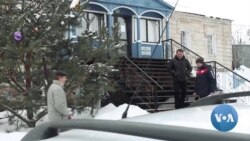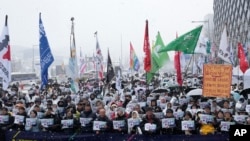ໃນຂະນະທີ່ຄວາມພະຍາຍາມເພື່ອຫຼຸດຜ່ອນຄວາມເຄັ່ງຕຶງລະຫວ່າງ ມົສກູ ແລະ ກີຢິບ ດຳເນີນຢູ່ນັ້ນ, ພົນລະ ເຮືອນຢູ່ຕາມເຂດຊາຍແດນ ແມ່ນກຳລັງວາງແຜນສິ່ງທີ່ເຂົາເຈົ້າຈະເຮັດຖ້າ ຣັດເຊຍ ບຸກລຸກ ຢູເຄຣນ. ນັກຂ່າວວີໂອເອ ໂອເລນາ ອາດາເມັນໂກ ໄດ້ລົມກັບປະຊາຊົນທີ່ອາໄສຢູ່ໃນທ້ອງຖິ່ນໃນພາກພື້ນ ຊູມີ ທາງພາກຕາເວັນອອກສຽງເໜືອຂອງ ຢູເຄຣນ ໃນລາຍງານນີ້, ເຊິ່ງ ພຸດທະສອນ ຈະນຳລາຍລະອຽດ ມາສະເໜີທ່ານໃນອັນດັບຕໍ່ໄປ.
ນາງ ຢູເລຍ ວິດຄອຟສກາ ອາຍຸ 40 ປີ ແມ່ນພະຍາບານ ແລະ ທະ ຫານກອງໜູນ ສຳລັບກອງກຳລັງປ້ອງກັນເຂດແດນ ໃນພາກຕາເວັນອອກສຽງ ເໜືອຂອງ ຢູເຄຣນ.
ນາງ ຢູເລຍ ວິດຄອຟສກາ ກ່າວວ່າ “ການຢູ່ປະມານ 50 ກິໂລແມັດຫ່າງຈາກເຂດຊາຍແດນ ຣັດເຊຍ ແມ່ນບໍ່ໄກ. ການຖືກລະດົມຍິງໂດຍລະບົບຍິງລູກສອນໄຟ BM-21 Grad ເຕັມໆພຽງຄັ້ງດຽວ ແລະ ເມືອງ ຊູມີ ກໍ່ຈະມຸ່ນໝົດ. ແລ້ວຂ້ອຍຄວນເຮັດຫຍັງ? ນັ່ງຢູ່ຊາກຫັກພັງທີ່ວ່ານີ້ ແລະ ລໍຖ້າໃຫ້ຄົນມາຊ່ວຍເຮົາບໍ? ບໍ່, ບໍ່.. ຖ້າມັນມີຄວາມຕ້ອງການ, ຂ້ອຍຈະເຮັດໃຫ້ດີທີ່ສຸດເພື່ອພາຄອບຄົວຂອງຂ້ອຍ ໜີອອກຈາກບ່ອນນີ້. ແມ່ຂອງຂ້ອຍແມ່ນເຖົ້າແລ້ວ ແລະ ລາວກໍບໍ່ສະບາຍ, ລູກຊາຍຂອງຂ້ອຍແມ່ນນັກຮຽນ.. ຂ້ອຍຈະຮັບປະກັນວ່າເຂົາເຈົ້າຕ້ອງໜີອອກໄປ, ແຕ່ຂ້ອຍຈະຢູ່, ຂ້ອຍບໍ່ຢາກໜີຈາກບ້ານຂອງຂ້ອຍໃຫ້ພວກຫົວເມືອງຂຶ້ນມາຢູ່ທີ່ນີ້.”
ນັກເຄື່ອນໄຫວທ່ານ ແອນດຣີ ບູກິນ ເວົ້າວ່າ ລາວບໍ່ໄດ້ໂດດດ່ຽວ.
ທ່ານ ແອນດຣີ ບູກິນ, ນັກເຄື່ອນໄຫວຢູ່ພາກພື້ນ ຊູມີ ກ່າວວ່າ “ສອງສ່ວນສາມຂອງໝູ່ຂອງຂ້າພະເຈົ້າ ຖ້າບໍ່ແມ່ນຫຼາຍກວ່ານີ້ ຈະປົກປ້ອງພາກພື້ນ ຊູມີ ຂອງພວກເຮົາ ແລະ ຕົວເມືອງຜ່ານທາງການ ຫຼືບໍ່ກໍອົງການຈັດຕັ້ງອາສາສະໝັກ. ບັນຫາແມ່ນຮຸນແຮງເປັນພິເສດ ຖ້າ “ພວກທະຫານຊຸດຂຽວ” ປາກົດຕົວຄືໃນປີ 2014 ຢູ່ແຫຼມໄຄຣເມຍ.”
ນີ້ແມ່ນເມືອງ ຄອສຕຽນຕີນິຟກາ (Kostyantynivka) ນຶ່ງໃນປະມານ 30 ເມືອງໃນພາກພື້ນ ຊູມີ ທີ່ຕັ້ງຢູ່ໃກ້ກັບເຂດຊາຍແດນ ຣັດເຊຍ.
ທ່ານ ມີໂຄລາ ໂຕຣີອານິກ, ຈາກຊຸມຊົນເຂດແດນປະສົມ ໂຄຕິນ ກ່າວວ່າ “ຢູ່ພຸ້ນໃນອີກຟາກນຶ່ງ, ເຈົ້າສາມາດເຫັນບ່ອນທີ່ສວນຜັກສຸດຢູ່, ມັນແມ່ນ ຣັດເຊຍ. ສວນຜັກຂອງປະຊາຊົນແມ່ນຍາວຢຽດ ໄປຮອດເຂດຊາຍແດນ.”
ທ່ານ ມີໂຄລາ ໂຕຣີອານິກ ແມ່ນປະທານຂອງຊຸມຊົນເຂດແດນປະສົມ ໂຄຕິນ, ເຊິ່ງລວມມີ 10 ໝູ່ບ້ານໃນທ້ອງ ຖິ່ນ. ປັດຈຸບັນນີ້ລາວໄດ້ກ່າວວ່າມັນບໍ່ໄດ້ມີກິດຈະກຳຫຍັງຫຼາຍ.
ທ່ານ ມີໂຄລາ ກ່າວວ່າ “ບາງຄັ້ງພວກເຮົາຈະເຮັດເຮືອບິນລຳນ້ອຍບິນຜ່ານ, ບາງເທື່ອແມ່ນກອງກຳລັງເຂດຊາຍ ແດນ. ໃນເວລານັ້ນ, ຂ້າພະເຈົ້າສາມາດເຫັນເຮືອບິນຂອງພວກເຮົາ, ພ້ອມກັບຂອງເຂົາເຈົ້າ. ມັນໄດ້ມິດງຽບແລ້ວ.”
ແຕ່ປະຊາຊົນແມ່ນບໍ່ສະບາຍໃຈ.
ທ່ານ ມີໂຄລາ ກ່າວວ່າ “ປະຊາຊົນແມ່ນບໍ່ພາກັນໜີ, ແຕ່ເຈົ້າສາມາດຮູ້ສຶກເຖິງຄວາມເຄັ່ງຕຶງ. ເຂົາເຄີຍເວົ້າ ກ່ຽວ ກັບ ອາຍແກັສ, ລາຄາອາຫານທີ່ເພີ່ມຂຶ້ນ, ການເມືອງ ແລະ ມື້ນີ້ເວລາໃດທີ່ຄົນພົບກັນ, ຢູ່ຮ້ານຄ້າ ຫຼື ບ່ອນອື່ນໆ, ເຂົາ ເຈົ້າມັກຈະເວົ້າວ່າ “ເປັນແນວໃດ, ເຈົ້າໄດ້ຍິນຫຍັງບໍ່? ມັນຈະມີສົງຄາມຫຼືບໍ່?”
ບັນດາເຈົ້າໜ້າທີ່ກ່າວວ່າ ມັນໄດ້ມີການເຈລະຈາ ກ່ຽວກັບ ການຂະຫຍາຍຈຳນວນກອງກຳລັງທະຫານໃນພາກພື້ນ ຊູມີ.
ທ່ານ ດີມິໂຕຣ ຊີວິດສກີ, ຈາກຫ້ອງການລັດໃນພາກພື້ນ ຊູມີ ກ່າວວ່າ “ພ້ອມກັນກັບກະຊວງປ້ອງກັນປະເທດ ພວກເຮົາແມ່ນກຳລັງປຶກສາຫາລື ຄວາມເປັນໄປໄດ້ ກ່ຽວກັບ ການມີນຶ່ງ ຫຼື ສອງໜ່ວຍທະຫານຢູ່ທີ່ນີ້. ຫຼັງເດືອນກຸມພາ, ພວກເຮົາຈະຈັດການຊ້ອມລົບໃຫ້ກອງກຳລັງປ້ອງກັນເຂດແດນ. ມັນຈະເປັນການຊ້ອມລົບແບບເຕັມອັດຕາ”
ແຕ່ນາງ ຢູເລຍ ວິດຄອຟສກາ ເວົ້າວ່າເຂົາເຈົ້າແມ່ນບໍ່ມີຄວາມພ້ອມຄືທີ່ເຂົາເຈົ້າຄວນເປັນ.
ນາງ ຢູເລຍ ກ່າວວ່າ “ຂ້ອຍບໍ່ເຫັນການຕອບສະໜອງທີ່ເໝາະສົມຈາກອົງການຕ່າງໆທີ່ຕ້ອງການເພື່ອຮັບມືກັບບັນຫານີ້ໃນຊ່ວງເວລາທີ່ຫຍຸ້ງຍາກດັ່ງກ່າວ. ມັນເປັນໄປບໍ່ໄດ້ທີ່ຈະຮຽນຮູ້ ໃນລະຫວ່າງການຊ້ອມລົບນຶ່ງຫຼືສອງຄັ້ງ.”
ນາງ ວິດຄອຟສກາ ຕອນນີ້ມີແຜນທີ່ຈະເລີ່ມການຮຽນປ້ອງກັນພົນລະເຮືອນ ພ້ອມກັບໝູ່ຂອງລາວຈຳນວນນຶ່ງ, ໃນຂະນະທີ່ເຂົາເຈົ້າກຽມພ້ອມສຳລັບອະນາຄົດທີ່ບໍ່ແນ່ນອນ.
As efforts to calm tensions between Moscow and Kyiv continue, civilians along the border are planning what they will do if Russia invades Ukraine. For VOA, Olena Adamenko spoke to residents in the Sumy region of northeast Ukraine in this story narrated by Anna Rice.
40-year old Yulia VitkOvska is a nurse and reservist for territorial defense forces in northeastern Ukraine
“Being some 50 kilometers from the Russian border is not far. One full salvo from a BM-21 "Grad" – and the city of Sumy is in ruins. What should I do – sit in these ruins and wait for someone to come and save us? No, no… If there is a need, I’ll do my best to get my family out of here. My mom is elderly and she’s sick, my son is a student… I’ll make sure they leave, but I’ll stay, I don’t want to leave my home for some occupant to live here.”
Activist Andriy Bukin says she’s not alone.
“Two-thirds of my friends if not more will protect our Sumy region and the city through either official or volunteer organizations. The issue is especially acute if the “little green men” show up – just like in 2014 in Crimea.”
This is Kostyantynivka – one of about 30 cities in the Sumy region near the Russian border.
“Over there on the other side, you can see where the vegetable patches end, there’s Russia. People’s vegetable patches stretch right up to the border!”
Mykola ToriAnyk is chairman of the Khotyn Amalgamated Territorial Community, which includes 10 local villages. So far, he says, there hasn’t been much activity.
“Sometimes we see planes pass by, small ones, maybe border forces. At times, I can see our planes, as well as theirs. It’s been quiet.”
Still people are anxious.
“People are not leaving, but you can feel the tension. They used to talk about gas, rising food prices, politics, and today whenever people meet – by a store or anywhere else, they always say, “Well, have you heard anything? Is there going to be war or not?””
Local officials say there is talk about increasing the number of military forces in the Sumy region.
“Together with the Ministry of Defense we’re discussing the possibility of having one or two more brigades here. Over February, we’ll hold drills for the Territorial Defense Forces. It’ll be a full-scale drill.”
But Yulia Vitkovska says they aren’t as prepared as they should be.
“I don’t see the appropriate response from the structures that need to deal with this in such a difficult time. It’s impossible to learn during one or two drills!”
Vitkovska now plans to start civil defense courses together with some of her friends, as they continue to prepare for an uncertain future.










